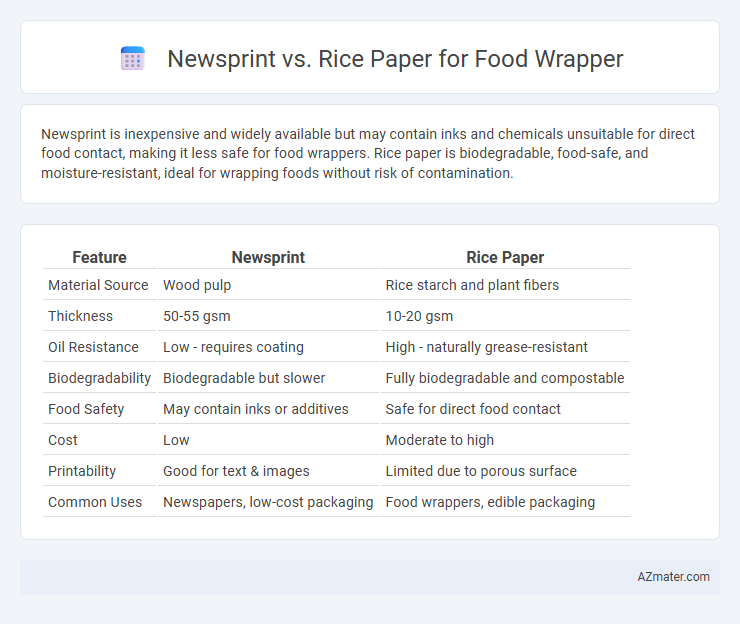Newsprint is inexpensive and widely available but may contain inks and chemicals unsuitable for direct food contact, making it less safe for food wrappers. Rice paper is biodegradable, food-safe, and moisture-resistant, ideal for wrapping foods without risk of contamination.
Table of Comparison
| Feature | Newsprint | Rice Paper |
|---|---|---|
| Material Source | Wood pulp | Rice starch and plant fibers |
| Thickness | 50-55 gsm | 10-20 gsm |
| Oil Resistance | Low - requires coating | High - naturally grease-resistant |
| Biodegradability | Biodegradable but slower | Fully biodegradable and compostable |
| Food Safety | May contain inks or additives | Safe for direct food contact |
| Cost | Low | Moderate to high |
| Printability | Good for text & images | Limited due to porous surface |
| Common Uses | Newspapers, low-cost packaging | Food wrappers, edible packaging |
Introduction to Food Wrappers: Newsprint vs Rice Paper
Newsprint and rice paper serve distinct roles in food wrapping due to their material properties and safety standards. Newsprint, made from recycled paper, is often used for temporary wrapping but lacks food-grade certification and can contain ink toxins, posing health risks. Rice paper, derived from natural starches and rice flour, offers a food-safe, biodegradable option that is grease-resistant and suitable for direct contact with food.
Composition and Manufacturing of Newsprint
Newsprint is primarily composed of mechanical wood pulp derived from softwood trees, combined with fillers such as clay and chalk to enhance brightness and opacity. Its manufacturing process involves thermomechanical pulping that retains most of the lignin, imparting a relatively coarse texture ideal for temporary food wrappers. In contrast, rice paper is made from natural plant fibers like rice straw or tapioca, processed through soaking, blending, and drying techniques resulting in a thinner, more delicate wrapper commonly used for fresh food applications.
What is Rice Paper? Origins and Features
Rice paper, traditionally made from the starch of rice, is a thin, translucent edible sheet commonly used in Asian cuisine for wrapping spring rolls and other foods. Originating from East and Southeast Asia, rice paper is valued for its light texture, flexibility, and natural biodegradability, making it an eco-friendly alternative for food wrapping. It contrasts with newsprint, which is made from recycled paper and ink, lacking food-safe properties and suitable only for non-edible wrapping purposes.
Food Safety: Are Newsprint Wrappers Safe?
Newsprint wrappers are not food safe due to the presence of ink, dyes, and chemicals that can transfer harmful substances to food. Rice paper, made from natural starches and water, is free from harmful additives and is widely recognized as a safe and edible option for food wrapping. Choosing rice paper over newsprint ensures compliance with food safety standards and reduces the risk of chemical contamination.
Edibility and Allergen Potential of Rice Paper
Rice paper, made from natural ingredients like rice flour and tapioca starch, is generally safe for consumption and free from common allergens such as gluten and nuts, making it an edible and hypoallergenic option for food wrapping. In contrast, newsprint is composed of wood pulp and printed with inks containing potentially harmful chemicals, rendering it inedible and unsuitable for direct food contact. The allergen potential of rice paper remains low, supporting its widespread use in culinary applications, especially in Asian cuisine.
Environmental Impact: Biodegradability and Sustainability
Newsprint and rice paper differ significantly in environmental impact regarding biodegradability and sustainability; newsprint, made from wood pulp, is generally biodegradable but often contains inks and chemicals that slow decomposition and may release toxins. Rice paper, derived from natural plant fibers such as rice straw or mulberry bark, is fully biodegradable and compostable, posing minimal environmental harm. Sustainability favors rice paper as it utilizes renewable resources and requires less energy-intensive processing compared to the wood-based production of newsprint.
Cost Comparison: Newsprint vs Rice Paper
Newsprint is significantly more cost-effective than rice paper, making it a preferred choice for businesses seeking affordable food wrappers. While rice paper offers a natural, biodegradable option, its production costs and price per sheet are notably higher, impacting overall packaging expenses. Choosing newsprint can reduce material costs by up to 50%, benefiting high-volume food packaging without compromising basic functionality.
Culinary Uses: Popular Foods Wrapped in Newsprint
Newsprint is commonly used in culinary applications for wrapping greasy or oily foods such as fish and chips, as its porous texture absorbs excess moisture, keeping food crisp. Rice paper, favored in Asian cuisine, is utilized for wrapping fresh ingredients like spring rolls and Vietnamese summer rolls, providing a delicate, edible wrapper that enhances presentation and flavor. While newsprint is practical for takeout foods, rice paper offers a versatile, gluten-free option ideal for fresh, light dishes.
Modern Applications of Rice Paper in Food Wrapping
Rice paper is increasingly favored in modern food wrapping for its edible, biodegradable, and gluten-free properties, making it ideal for sustainable packaging solutions in the culinary industry. Unlike traditional newsprint, rice paper does not transfer ink or toxins to food, ensuring safety and maintaining flavor integrity, which is crucial for fresh and delicate dishes like spring rolls or sushi. Its thin, translucent texture provides an attractive presentation while reducing plastic waste, aligning with eco-conscious dining trends.
Choosing the Right Wrapper: Practical Considerations
Newsprint offers affordability and widespread availability but may contain inks and chemicals unsuitable for direct food contact, making it less hygienic for wrapping food. Rice paper provides a natural, edible option free from harmful substances, enhancing food safety and presentation, especially for fresh or delicate foods. When choosing the right wrapper, consider food type, potential ink contamination, environmental impact, and regulatory compliance to ensure practical and safe use.

Infographic: Newsprint vs Rice Paper for Food Wrapper
 azmater.com
azmater.com